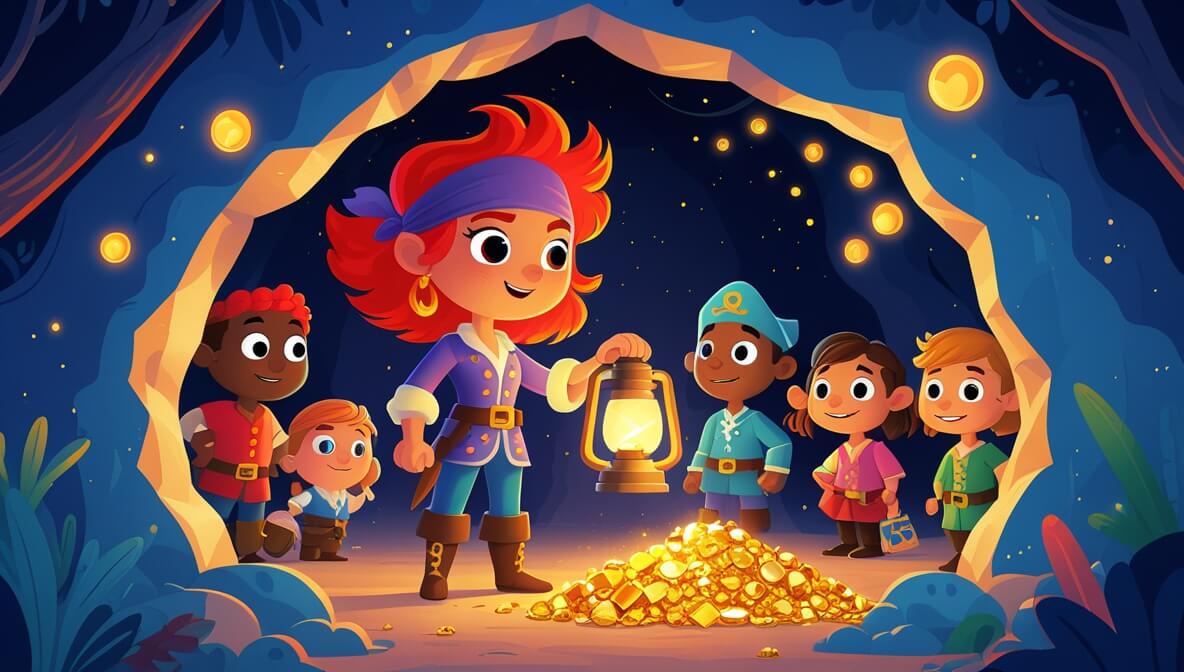Join the adventure of Captain Ruby and her loyal crew as they set sail to uncover hidden treasures on the mysterious Isle of Echoes.
Age Recommendation
3 – 12 years
Characters
Characters:
- Captain Ruby (fearless and clever pirate leader)
- First Mate Finn (loyal and resourceful sailor)
- Navigator Zara (keen-eyed map reader)
- Deckhand Leo (energetic and adventurous helper)
Story
Once upon a time, in the vast blue sea, Captain Ruby and her crew sailed aboard the ship called the “Crimson Sea Star.” They were in search of the legendary treasure rumored to be hidden on the Isle of Echoes. The wind was strong, and the waves splashed playfully against the ship’s hull. Captain Ruby held the ancient map firmly, her eyes glinting with excitement. “We are close, my friends!” she exclaimed. “Soon, we will uncover the secrets of the island!”
The Whispering Winds
As the crew approached the Isle of Echoes, the winds began to whisper strange tales. Navigator Zara leaned over the map, tracing the path with her finger. “We must follow the song of the seagulls,” she advised. First Mate Finn nodded, steering the ship towards the sound. Suddenly, a flock of seagulls appeared, guiding them to a hidden lagoon where the water shimmered like emeralds.
The Mysterious Cave
Once on the island, the crew set off in search of the treasure. They stumbled upon a mysterious cave, its entrance covered in vines. “This must be it,” Deckhand Leo whispered, his eyes wide with wonder. Inside, the cave was dark and echoey. Captain Ruby led the way, holding a lantern that cast flickering shadows on the walls. “Keep close, everyone,” she instructed, her voice echoing softly.
Challenges and Bravery
The cave was filled with twists and turns, and the crew faced many challenges. At one point, they had to cross a bridge made of slippery stones. “I’ll go first,” First Mate Finn offered bravely. With careful steps, he led everyone safely across. Just as they thought they were lost, the lantern light revealed a hidden door with ancient carvings.
The Hidden Treasure
Behind the door was a room filled with glittering gold and sparkling jewels. Captain Ruby and her crew gasped in awe. “We’ve found it, the treasure of the Isle of Echoes!” she declared triumphantly. Deckhand Leo danced with joy, while Navigator Zara studied the carvings, which told the story of the island’s ancient protectors. “This treasure is our reward for working together,” Captain Ruby smiled.
After celebrating their discovery, the crew decided to take only a small portion of the treasure, leaving the rest for future adventurers. They sailed back to the Crimson Sea Star, ready for their next adventure, knowing that their bond and bravery were the greatest treasures of all.
The end.
Moral of the Story
This story teaches us the importance of teamwork and bravery. By working together and facing challenges with courage, we can achieve great things and discover hidden treasures within ourselves.
Questions to Think About
- How did the crew find their way to the Isle of Echoes?
- What challenges did they face in the cave?
- Why did Captain Ruby decide to leave some treasure behind?
- What can we learn from the crew’s adventure?
- How would you feel if you discovered a hidden treasure?
Do You Know
- The first known pirate activity was recorded over 3,000 years ago in the Mediterranean Sea.
- The Jolly Roger, a famous pirate flag, often featured a skull and crossbones.
Word Explorer
- Lagoon: A shallow body of water separated from a larger sea.
- Navigator: A person who plans and directs the course of a ship.
- Treasure: A collection of valuable items like gold and jewels.
Emotions in the Story
- Excitement: When Captain Ruby and her crew set sail for the Isle of Echoes, eager to find the treasure.
- Bravery: When First Mate Finn crossed the slippery stone bridge to help his friends.
- Joy: When the crew discovered the hidden treasure room filled with gold and jewels.
Color Your Scene
Imagine the moment when the crew discovers the hidden treasure room. Picture the gold and jewels sparkling in the lantern light. Draw the room with vibrant colors, like the deep blue of the ocean, the shimmering gold of the treasure, and the flickering orange of the lantern flame.
Parents’ Corner
This story is a wonderful opportunity to discuss with your child about:
Teamwork: Emphasize how Captain Ruby and her crew relied on each other’s strengths to find the treasure.
Bravery: Talk about how the crew faced their fears in the dark cave.
Respect for history: Encourage your child to appreciate the stories behind ancient legends and treasures.
Sharing and kindness: Discuss why the crew left some of the treasure for future adventurers, promoting the idea of sharing what you have with others.











